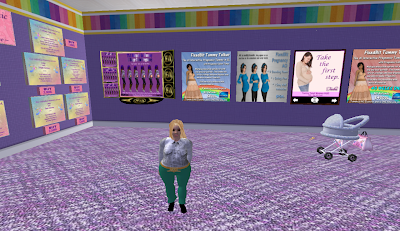 Deciding what outfits to try on
Deciding what outfits to try onDespite being a member of a major Second Life research project, I have always been a tad ambivalent about it. To be honest, at times I have found it intimidating and boring. It has taken me ages to build any sort of skill level, and I am limited in the times I can go into Second Life by poor Internet connection and inadequate computer equipment. So if I feel like that (and I am motivated to use Second Life in my teaching and professional life), how can we engage students and lecturers who lack motivation?
I think the answer to engaging newbies in Second Life is to make their experience a 'fun' and social experience. If people have fun and enjoy themselves, then they will keep returning and build their skills. Once they are comfortable in Second Life, then they'll be ready to take on the more complicated scenarios that we are asking them to work through in the virtual birth unit.
Aastra (Deborah Davis)
Having fun in Second Life
This is no new revelation - but it was really brought home to me today.
Usually I look around places in Second Life by myself. I very rarely see anyone to speak to, and even if I do, I often feel too intimidated to talk to them. So if there little or no interaction, I get very bored very quickly, take myself out of Second Life and go and talk to people on Twitter.
Petal (me) - does this purple dress make my skin look sallow??!!
Learning in Second Life is a social experience
But today I had a quick look at the Centre for Interprofessional e-learning (CIPeL) with Deborah Davis (Aastra Apfelbaum), which has been developed by Coventry University. Deborah and I had been alerted to the work of the CIPeL by midwifery educator, Elinor Clarke - Elinor is showing people around the CIPeL unit next Tuesday as part of the 24 hour Virtual International Day of the Midwife celebrations.
We had planned on looking for the midwifery section of the Centre, but got no further than the ground floor where we had the opportunity to try on new frocks and have a dance. To say we were thrilled is an understatement. We have been thinking that we need to get dressed up for the opening of the virtual birth unit and International Day of the Midwife. And let's face it, Petal (me in Second Life) is long overdue for a makeover.
Working together
What struck me was how much I learned about Second Life whilst having fun and being frivolous. I become so much more confident with changing clothes, using animations and accessing my inventory. The key to this experience was having someone to share the fun with - to give me advice about whether my bum looked too big in the purple outfit - and to problem-solve together.
Introducing newbies to Second Life
As I said before, this concept is nothing new to the people like the SLENZ team who are designing learning activities in Second Life.
But it is worth emphasing: if you are thinking about using Second Life as a teaching activity/resource, make sure you integrate time for people to become familiar with how Second Life works, with fun activities. And also make sure that people work together so they can share experiences and support each other as they are learning.
What advice would you give people new to Second Life? If you are new to Second Life, what would you like more information about?



































